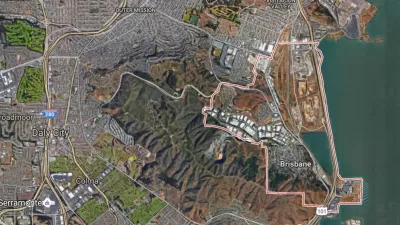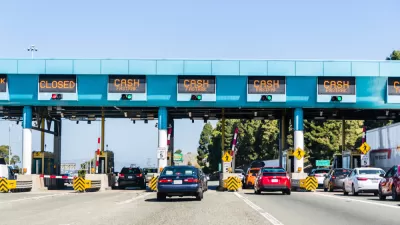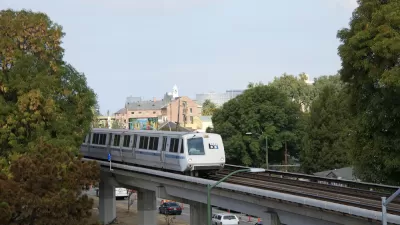Brisbane, a city of about 4,700 on the southern border of San Francisco, will vote on a controversial ballot measure in November to approve or reject a mixed-use development including up to 2,200 residential units on a 660-acre vacant brownfield.

The project, known as Brisbane Baylands, has received national attention as it illustrates California's housing crisis, exposing the conflict between suburban communities resisting new housing construction and meeting the Bay Area's housing demand. The site is directly served by the San Francisco-to-San Jose commuter rail line, enabling a 2-stop, 12-minute trip to the San Francisco Caltrain terminal.
"The Brisbane City Council agreed Thursday, July 19, to call a fall election seeking voter approval for construction of up to 2,200 residential units and 7 million square feet of commercial space on the 684-acre [former] landfill abutting the Bayshore," reports Austin Walsh for the San Mateo Daily Journal.
The proposed project is roughly twice the size of Brisbane, where there are currently 2,050 housing units and approximately 5.8 million square feet of commercial space.
The decision marks the most significant step forward in more than a decade for the project proposed by Universal Paragon Corporation, as residents, officials and others have spent years deliberating over whether the site adjacent to the county’s northern border is suitable for development.
The city council voted unanimously on three measures: certifying the Environmental Impact Report, approving 1,800 to 2,200 housing units, and placing the Baylands General Plan Amendment [pdf] on the November 6 ballot. A fourth measure, dealing with commercial development, was not unanimous. From the city's project update:
Include up to 7 million square feet of commercial (Councilmember O’Connell stated she was more comfortable with 4.5 million square feet and thus dissented in her vote). Other Councilmembers expressed how they believed that 7 million sq. ft. would allow for the City to have the most amount of future flexibility, amenities, and financial benefit, as well as be best able to assist with the regional jobs-housing imbalance.
What happens if voters reject project in November?
This may have been the most interesting part of Walsh's report because there's a good likelihood this may be the result and the uncertainty that would follow.
Failure at the ballot box would invite more uncertainty, as officials acknowledge the mounting pressure placed on Brisbane to help build an adequate amount of housing to accommodate the regional imbalance of available jobs.
To date, the largest squeeze on Brisbane was posed last year by draft legislation from state Sen. Jerry Hill, D-San Mateo, aiming to push forward housing at the site. The bill was not formally introduced due to local officials’ willingness to consider the development proposal during a series of public hearings...
Additional reading on Thursday's vote:
-
"Decision day arrives for Brisbane Baylands," also by Austin Walsh for The Daily Journal, July 19.
-
"Brisbane faces ballot vote on Baylands housing," Curbed SF, July 16.
FULL STORY: Baylands plan heads to vote

Alabama: Trump Terminates Settlements for Black Communities Harmed By Raw Sewage
Trump deemed the landmark civil rights agreement “illegal DEI and environmental justice policy.”

Study: Maui’s Plan to Convert Vacation Rentals to Long-Term Housing Could Cause Nearly $1 Billion Economic Loss
The plan would reduce visitor accommodation by 25% resulting in 1,900 jobs lost.

Planetizen Federal Action Tracker
A weekly monitor of how Trump’s orders and actions are impacting planners and planning in America.

Wind Energy on the Rise Despite Federal Policy Reversal
The Trump administration is revoking federal support for renewable energy, but demand for new projects continues unabated.

Passengers Flock to Caltrain After Electrification
The new electric trains are running faster and more reliably, leading to strong ridership growth on the Bay Area rail system.

Texas Churches Rally Behind ‘Yes in God’s Back Yard’ Legislation
Religious leaders want the state to reduce zoning regulations to streamline leasing church-owned land to housing developers.
Urban Design for Planners 1: Software Tools
This six-course series explores essential urban design concepts using open source software and equips planners with the tools they need to participate fully in the urban design process.
Planning for Universal Design
Learn the tools for implementing Universal Design in planning regulations.
Caltrans
Smith Gee Studio
Institute for Housing and Urban Development Studies (IHS)
City of Grandview
Harvard GSD Executive Education
Toledo-Lucas County Plan Commissions
Salt Lake City
NYU Wagner Graduate School of Public Service





























